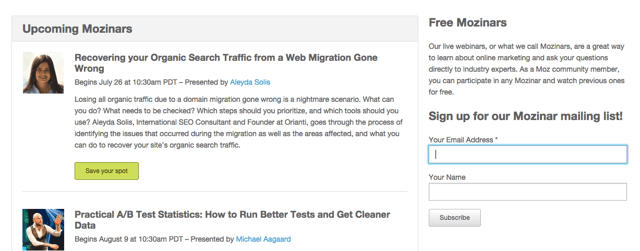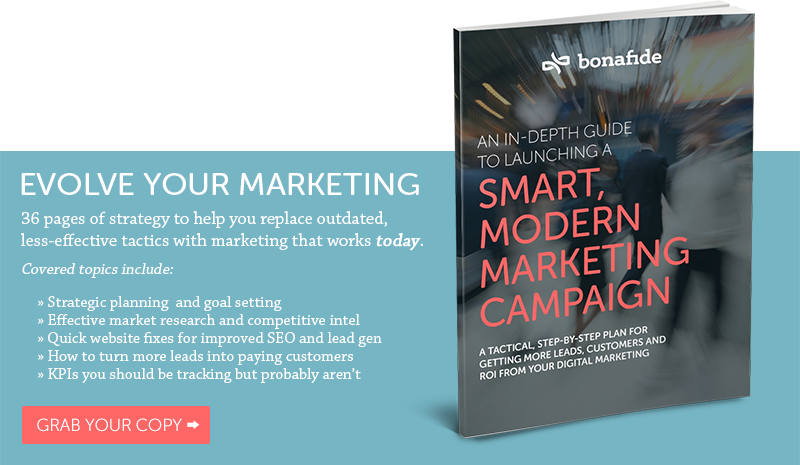
Today’s buyer expects to get what they want, when they want it.
But this isn’t only true for products and services -- it works for content, too.
When people are faced with the problem you solve, they go on a predictable journey that hopefully results in them becoming your new customer -- that is, if you do a better job than your competition of being their trusted resource through resolving their issue.
This journey is called the buyer’s journey, and it comes in three stages:
- Awareness
- Consideration
- Decision
At each stage, content that anticipates and responds to your buyer’s questions is what guides them through the buyer’s journey and towards purchasing from you.
Awareness Stage
Buyers need to research a solution to their problems before they even consider pulling out their wallets. If your product or service is a larger purchase, this is especially true.
You know this.
But did you realize that you have a bunch of buyers out there who don’t even know they have a problem? They may see the problem you solve as a minor annoyance they need to just live with. And until they fully appreciate the cost of their problem, getting them to buy a solution to it is damn-near impossible.
So, you need to focus on meeting them where they are in the buyer’s journey -- the awareness stage.
The awareness stage is all about showing buyers that their pain point is a significant problem in need of a solution.
At this stage, buyers are asking questions like:
- What is causing my specific pain point?
- How can I remove this pain point?
- Is there a different way of doing this job?
- What’s this problem costing me in time, money, quality etc.?
Yes, it's tempting to showcase your awesome solution, especially when the visitor has the exact problem you solve, but this isn’t the time. If you do, you will come across as “salesy”(read: "sleazy") rather than helpful.
Content for the Awareness stage
At this stage, your main goal is to earn a spot in your buyer’s brain -- you want to be top of mind.
Focus your content on your buyer’s problems and pain points. Give them enough information so they know what needs to be fixed and how critical finding a solution is. Help them see that no one understands them and their problems as well as you do.
Show them how much they need you.
When you finally pitch your solution, they will be more likely to believe you can actually solve their problem because they know you at least understand it.
Good awareness stage content:
- Blog posts: Focus blog posts on exploring your buyer’s problems and pain points and be specific. Don’t try to please everyone -- focus on topics your ideal buyers will find helpful.

- Whitepapers: Release research that digs deep into your buyer’s specific problems. Uncover the cost of their problems in time, money, quality, etc. But remember, don’t pitch your project -- at most, brand the whitepaper with your logo and contact details.
- Guides: Help buyers look at their own company and self-diagnose the problem you solve.
- Tip sheets: Publish easily digestible tip sheets that help buyers understand their problem. One strategy is to include tip sheets as downloadable content within a related blog post works well and is a great way to build your email list.
- Checklists: Create a checklist that helps them identify where their problem is.
- eBooks: eBooks provide an in-depth look at their problems. Producing one requires a larger investment of time (and sometimes money), but it shows authority on your topic. Perhaps, you can repurpose a series of blog posts into an eBook to save yourself some time.
- Videos: Videos are great for engaging visual learners that don’t want to read your 2,000+ word blog posts.
Each piece of content your buyers find valuable goes a long way towards building trust and warming them up for your pitch.
Consideration Stage
By the consideration stage, your buyers are fully aware of their problem, how much it’s costing them, and that they need a solution.
Now, they're finally ready to learn more about how you and your competitors (mainly you) can help.
They want to know:
- How do I solve my problem?
- Should I do what I’m currently doing, only better? Or, do I need to try something completely different?
- What are the best products/services that solve my problem?
At this stage, it’s important to have a unique selling proposition (USP) that appeals to your ideal customer. Your USP lets customers know why they should pick you over the competition.
Content for the Consideration stage
You want to position your solution as the obvious choice, so it's important to infuse each piece of product-focused content with your USP.
Good consideration stage content:
- Blog posts: Unlike awareness stage blog posts, now you should be matching problems to specific features of your offering. Introduce a problem to create context and then show how this problem is eliminated with your solution.
- Whitepapers: Get specific with how your product fixes their problem. Include data to back up your claims whenever possible.
- Webinars: Invite buyers to a live webinar that shows them your product works and how it'll make their lives better.

- Case studies: Show how your product solved problems for similar businesses. A great case study covers life before your solution, the buying process, transitioning to your solution, their experience with your solution, and finally, the results. Also, the more specific you can get around metrics, the more convincing your case study will be.
- Samples: This really only works for physical products.
- Product spec sheets: Give them specific technical details about your product. Side-by-side comparisons with competitors' products are pretty impactful, too.
- Catalogs: Let them know the full range of products and/or services you offer.
Again, these content pieces should focus on how your tool/service solves their problem. They want to know, in detail, how your product makes their life easier and why they should choose you.
Decision Stage
Congratulations! You’ve convinced the buyer that you have a solution to their problem.
But -- now you have to close the deal.
By now, buyers know all about you and your competitors. They are pouring over pros and cons and making sure your product meets all of their requirements. They want answers to nitty gritty details like:
- Who has the best price?
- Who has a proven track record of solving my problem?
- How long will it take me to implement this solution and train my staff?
- How long will it take me to see a return on my investment?
They’re one step away from making a decision and just need a little push. Alleviate any last minute doubts that are causing them to hesitate by providing some anxiety-crushing content.
Content for the Decision stage
The type of content you provide depends on your solution’s price point.
For example, if you’re selling a $10 per month service, you can't really justify the time you'd need to invest to give everyone with a 1-on-1 demo. But at $500+ per month, it’s easy and even expected that you give each potential client some personal attention.
For inexpensive products and services, consider:
- Free trials: Give them a chance to experience your full product for free.
- Forever free plans: If you’re a low cost SaaS solution, provide a limited version of your product that keeps them engaged while solving some of their smaller problems.
- Recorded demo videos: You can’t afford to give 1-on-1 demos at this price point, but you can still let them see your product in action with recorded demos.
- Clear pricing tiers: Let them know exactly what features and support they get at each price point.

- Coupons and discounts: If relevant, let them know how they can save money. For example, letting customers save money by paying for a longer commitment (e.g. annual v.s. monthly payments) is a great way to incentivize the purchase and while gaining loyalty.
- Automated sales emails: Even if you can’t provide a dedicated salesperson, you can still provide value the way a salesperson would with pre-scheduled emails. Just make them as authentic as possible. You're not trying to dupe anyone.
For more expensive products, buyers will want:
- 1-on-1 Demos: Invite your main contact and key decision makers to see your product in action. Encourage them to ask questions along the way.
- Free consultations: A chance to speak about their specific problems and how you can help.

- Tailored sales deck: Take the time to develop a custom sales pitch that speaks about their issues and explains how your solution fits into the picture.
- Custom estimates or quotes: One-size-fits-all pricing may not work for this crowd, especially when you get into enterprise customers. You may need to pitch and justify custom pricing for these customers.
- Information about startup/implementation difficulty: Let them know how quickly and easily they can get up and running with your solution and whether or not ongoing training/consulting is required.
- Details about customer support: Make sure they know what kind of help and support they’ll get.
Remember -- when you’re selling a product or service that is more expensive than what a middle manager can approve themselves, you’ll need to sell to the executive team, as well. These higher ups are more concerned with a cost/benefit analysis, how it compares to alternatives, and how much money they will make/save by going with you. While speaking about how you solve your end user’s problems gets you a seat at the table, you won’t close the deal if upper management can’t see the ROI.
Be Your Customer’s Trusted Guide
Buyers will not always land on your site at the beginning of their journey. Sometimes they’re already aware of their problem and considering solutions before reaching your site. They might even be looking to buy because one of your competitors already guided them through the awareness and consideration stages. That’s why you need to make content for all three stages easily accessible and tailored to their current stage.
When you do, buyers find the information they want when they need it. You become their trusted guide as they move through the buyer’s journey until they finally reach the right conclusion...
Buying your product or service.




